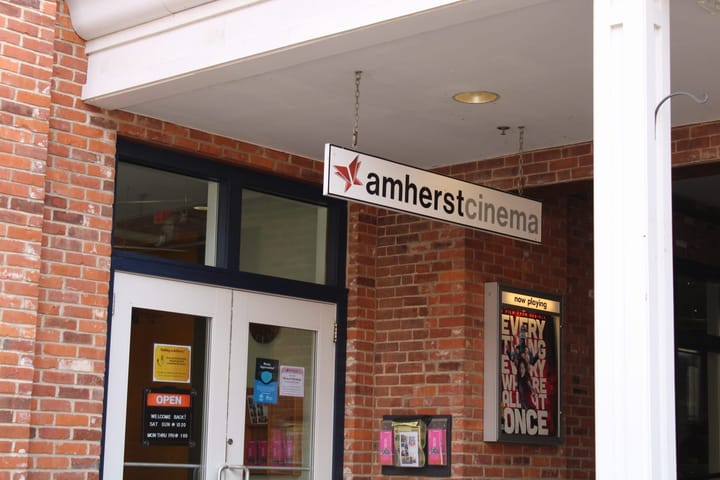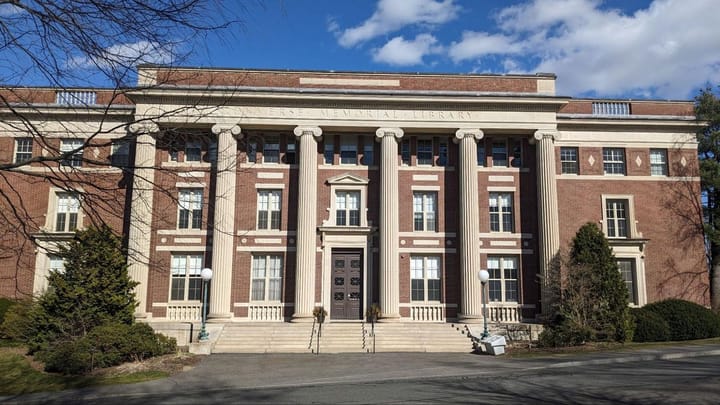College Hosts Moderna President Stephen Hoge '98 in Virtual Event
The college hosted President of Moderna Stephen Hoge ’98 on Friday, April 23 as a part of the virtual Stories in STEM event series. The Cambridge-based biotechnology company has experienced tremendous growth since the pandemic began, as it has developed one of the world’s most effective vaccines against Covid-19. With the vaccine becoming widely available across the country, Hoge spoke to students about his journey through STEM and discussed the work that Moderna is doing to vaccinate Americans.
At the beginning of his presentation, Moderna President Dr. Stephen Hoge ’98 looked at the audience from the Zoom spotlight with a wide smile and joked, “It’s more nerve-wracking to speak to this group than it was to speak to the U.S. Congress.”
Hoge was invited to his alma mater as part of the Stories in STEM event series. The series invites scientists to the college to speak about their journeys in STEM and answer student questions about their current careers.
Students particularly identified with Hoge’s Story in STEM since he had actually graduated from Amherst, earning a degree in neuroscience and playing on the football team. Audrey Rosevear ’22, a math major who attended the event, noted that she was immediately drawn in upon learning that Hoge was an alumnus because “he started from a place that could very well be my own.”
Hoge began the event by explaining where his passion for science began and how it evolved over time. In high school, Hoge loved science because it described his known world. To him, “science used to involve acquiring knowledge about the universe that was fascinating and useful in itself. But I left Amherst with a completely different perspective — that science actually is how you approach the unknown,” Hoge specified. “I think this has animated my entire career.”
His passion for science deepened throughout his undergraduate career. Hoge outlined three courses he took during his sophomore year at Amherst that elevated this infatuation with “the unknown” into a sort of spirituality: one focused on neurophysiology, a second dealing with psychopharmacology and a third about the history of science.
The neurophysiology course served as a gateway into the “dynamic” side of biology which deals with systems of neurons, he said. In psychopharmacology, Hoge saw the concrete, seemingly “fantastical” effects that these complex systems could produce in the human mind. Finally, in the history of science, Hoge began to see scientific knowledge as the main driver of human progress.
“It was this weird sort of reflection: science almost became a religion for me, this belief that all human progress — both forwards and backwards — is directed by science,” Hoge mused.
Of course, this combination of classes was fateful in terms of Hoge’s own career, but he also sees them as saying something greater about liberal arts education itself. He asserted that every scientist would benefit from studying STEM in a liberal arts environment: “That ability to translate between disciplines is something that you only get in a liberal arts school. You’re studying science, but you soak in the rest, because it’s integrated in the classes and in the community,” Hoge said.
Nisan Sele ’21, a neuroscience major and attendee of the event, said that she appreciated that Hoge acknowledged how a STEM education is enriched by other disciplines, and how science can have an almost spiritual value.
“What Dr. Hoge said, it made me feel validated — like I had ‘permission’ to take a gap year to experiment and reflect on what science means to me. That’s what I really want.”
Hoge got some of this reflection time while working on his own neuroscience thesis. “That act of doing basic science in the lab was tedious, and I didn’t always enjoy it. I started questioning whether I was cut out for this,” Hoge admitted. But when he started poring through scientific literature, Hoge regained that metaphysical sense of purpose. “I’d read a few papers. Then, 10 to 12 articles later, my head would be throbbing; I wouldn’t understand everything I’d read. But then that cloud of confusion, of the unknown, gains just a little bit of structure. And I loved that feeling,” Hoge enthused.
After he graduated from Amherst, Hoge continued his education on the West Coast. He earned an M.D. at the University of California, San Francisco before returning to the East Coast — New York City — to begin his residency in emergency medicine. Before working at Moderna, Hoge became a partner at McKinsey & Company in New York City.
“Emergency medicine was full of energy and it spoke to me in that I had to make quick decisions about triage,” he said. “But, after a while, it started to feel static — like high school science — in that it was just about applying prior knowledge,” Hoge explained. “I thought to myself, ‘If I’m going to do something for the next 10 to 20 years of my career, I want it to be much closer to the frontier of science.’”
In his words, Hoge fulfilled this vision of his career by a stroke of luck. Venturing to “the frontier of science” around 2012, he stumbled across Moderna — a young biotechnology startup centered around the idea that messenger RNA (mRNA) can be used to treat and prevent disease.
“If this was truly the practical potential of mRNA,” Hoge said, “science could progress at the speed of information knowledge. I didn’t care if I was the last employee, I was gonna see this thing through.”
Hoge had no idea that Moderna, being young and untraditional, would stick around for so long and that, nine years later, they would have developed the exact technology needed for the Covid-19 vaccine. Throughout the talk, Hoge expressed his disbelief: “I simply fell in love with mRNA biology; its beauty completely surpassed what I’d read about in textbooks. Our research progressed slowly, and then took off throughout the past five years. And all of a sudden, now, we’re trying to save the world.”
Moderna’s influence during the pandemic has gone far beyond their company’s doors. Their mRNA technology has been utilized both in their vaccine and in the Pfizer vaccine. “That’s why the efficacies against all infections are 94 percent and 95 percent, [respectively],” Hoge explained, “because [Pfizer] actually copied our technologies. And that’s not a bad thing, especially during a pandemic — science is about building off of your peers’ work.”
However, considering Moderna’s profit-driven vaccine distribution model, some students were skeptical that Moderna’s influence during the pandemic had been broadly positive. To acknowledge this, Rosevear asked Hoge what Moderna was doing to improve the equity of vaccine distribution internationally.
“We’ve delivered the first 200 million doses [of the vaccine] to the United States, and the reason why is twofold,” Hoge elaborated. “Firstly, the United States was the fastest and most aggressive buyer. And also, the United States has not yet allowed export of vaccines — principally because they’re focused on protecting their own citizenry.”
Hoge went on to describe how Moderna is attempting to broaden its supply chain. “In September 2020, we started building infrastructure to establish a manufacturing supply chain in Switzerland, Spain and France. From Europe, we’ll be able to export to the rest of the world — particularly to countries with fewer resources.”
Rosevear was dissatisfied with Hoge’s answer. She could tell Hoge had “clearly reflected” on the ways that his work is entangled with oppressive politics and capitalist economies, but he hadn’t “sunk enough energy” into translating his reflection into action.
“It’s difficult to find a career in STEM research that doesn’t exacerbate social inequities because most of your options are in the private sector or within academia,” Rosevear admitted. “I think if you want to avoid reinforcing these systems, you have to use your power within an institution to push for progress.”
Not all students were critical of Hoge’s work. For instance, Sele appreciated hearing Hoge’s side of the story as it made her more sympathetic to the challenges that Moderna faces.
“There is merit to both sides of the debate,” Sele admitted, “but seeing Hoge’s viewpoint was important to me. Especially considering that there’s only 1,000 of them working at Moderna, and that they really only accidentally ended up in this scenario — that perspective is often missing from the conversation.”
Regardless of their ethical evaluations, students valued the opportunity to hear about Hoge’s nontraditional journey through STEM. “I think it’s a really important lesson for a lot of Amherst students to learn that you truly don’t have to have everything figured out,” Sele remarked. “You should just follow your intuition. And if anyone proves that this works, it’s Dr. Hoge, considering the success he’s achieved.”
As Hoge told students during the event, his career path has been crooked, but “crooked paths are by far the most interesting.”





Comments ()